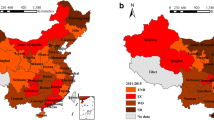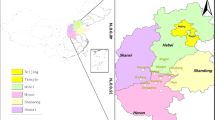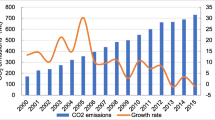Abstract
Carbon emissions are a major concern in China, and transportation is an important part of it. In this paper, data on China’s 30 provinces’ transport carbon emissions from 2005 to 2019 were selected to construct a spatial autocorrelation model and identified the decoupling types, which revealed the relationship between transport carbon emissions and economic development. This study suggests a regulation strategy for provincial transport carbon emissions in China based on the contribution rates of transport carbon emission variables. According to the findings, transport carbon emissions of China indicated a slow rise from 2005 to 2019, the annual growth rate has fluctuated downward, and petroleum products have been the most major source. The geographical correlation of transport carbon emissions has gradually improved, and the transport carbon emission intensity has become more significant. Differences in the transport carbon emission intensity slightly increased, which were significantly regionally correlated. There were seven forms of decoupling between yearly provincial transport carbon emissions and economic development, with weak decoupling accounting for the largest proportion, 45.24%. Decoupling was achieved in 83.33% of the provinces in the period of 2005–2019. As a consequence of factor decomposition, the energy intensity, transport intensity, and economic structure played an overall inhibitory role, while the carbon emission intensity, economic scale, and population played promoting roles. The economic scale was the most important influencing factor.


















Similar content being viewed by others
Data availability
All data materials analyzed during this study are included in this published article.
References
Ağbulut Ü (2022) Forecasting of transportation-related energy demand and CO2 emissions in Turkey with different machine learning algorithms. Sustain Prod Consum 29:141–157. https://doi.org/10.1016/j.spc.2021.10.001
Akimoto K, Sano F, Nakano Y (2022) Assessment of comprehensive energy systems for achieving carbon neutrality in road transport. Transp Res Part D: Transp Environ 112:103487. https://doi.org/10.1016/j.trd.2022.103487
Aminzadegan S, Shahriari M, Mehranfar F, Abramović B (2022) Factors affecting the emission of pollutants in different types of transportation: a literature review. Energy Rep 8:2508–2529. https://doi.org/10.1016/j.egyr.2022.01.161
Bhat A, Ordóñez Garcia J (2021) Sustainability and EU road transport carbon emissions from consumption of diesel and gasoline in 2000 and 2018. Appl Sci 11:7601. https://doi.org/10.3390/app11167601
Cao X, OuYang S, Liu D, Yang W (2019) Spatiotemporal patterns and decomposition analysis of CO2 emissions from transportation in the Pearl River Delta. Energies 12:2171. https://doi.org/10.3390/en12112171
Chen F, Zhao T, Liao Z (2020) The impact of technology-environmental innovation on CO(2) emissions in China’s transportation sector. Environ Sci Pollut Res 27:29485–29501. https://doi.org/10.1007/s11356-020-08983-y
Chen L, Zhang L, Wang Y, Xie M, Yang H, Ye K, Mohtaram S (2023) Design and performance evaluation of a novel system integrating water-based carbon capture with adiabatic compressed air energy storage. Energy Convers Manag 276. https://doi.org/10.1016/j.enconman.2022.116583
Demircan Cakar N, Gedikli A, Erdogan S, Yildirim DC (2021) A comparative analysis of the relationship between innovation and transport sector carbon emissions in developed and developing Mediterranean countries. Environ Sci Pollut Res 28:45693–45713. https://doi.org/10.1007/s11356-021-13390-y
Dujmović J, Krljan T, Lopac N, Žuškin S (2022) Emphasis on occupancy rates in carbon emission comparison for maritime and road passenger transportation modes. J Mar Sci Eng 10:459. https://doi.org/10.3390/jmse10040459
Farkas A, Degiuli N, Martić I, Vujanović M (2021) Greenhouse gas emissions reduction potential by using antifouling coatings in a maritime transport industry. J Clean Prod 295:126428. https://doi.org/10.1016/j.jclepro.2021.126428
Fleschutz M, Bohlayer M, Braun M, Henze G, Murphy MD (2021) The effect of price-based demand response on carbon emissions in European electricity markets: The importance of adequate carbon prices. Appl Energy 295:117040. https://doi.org/10.1016/j.apenergy.2021.117040
Ghahramani M, Pilla F (2021) Analysis of carbon dioxide emissions from road transport using taxi trips. IEEE Access 98573–98580. https://doi.org/10.1109/access.2021.3096279
Gustafsson M, Svensson N, Eklund M, Dahl Öberg J, Vehabovic A (2021) Well-to-wheel greenhouse gas emissions of heavy-duty transports: influence of electricity carbon intensity. Transp Res Part D: Transp Environ 93:102757. https://doi.org/10.1016/j.trd.2021.102757
Heidari E, Bikdeli S, Mansouri Daneshvar MR (2022) A dynamic model for CO2 emissions induced by urban transportation during 2005–2030, a case study of Mashhad, Iran. Environ Dev Sustain 1–20. https://doi.org/10.1007/s10668-022-02240-7
Huang Q, Ling J (2021) Measuring embodied carbon dioxide of the logistics industry in China: based on industry stripping method and input-output model. Environ Sci Pollut Res 28:52780–52797. https://doi.org/10.1007/s11356-021-16190-6
Inkinen T, Hämäläinen E (2020) Reviewing truck logistics: solutions for achieving low emission road freight transport. Sustainability 12:6714. https://doi.org/10.3390/su12176714
Kilian L, Owen A, Newing A, Ivanova D (2022) Exploring transport consumption-based emissions: spatial patterns, social factors, well-being, and policy implications. Sustainability 14:11844. https://doi.org/10.3390/su141911844
Kwakwa PA, Adjei-Mantey K, Adusah-Poku F (2022) The effect of transport services and ICTs on carbon dioxide emissions in South Africa. Environ Sci Pollut Res Int 1–12. https://doi.org/10.1007/s11356-022-22863-7
Li X, Ren A, Li Q (2022) Exploring patterns of transportation-related CO2 emissions using machine learning methods. Sustainability 14:4588. https://doi.org/10.3390/su14084588
Li G, Zeng S, Li T, Peng Q, Irfan M (2023) Analysing the effect of energy intensity on carbon emission reduction in Beijing. Int J Environ Res Public Health 20. https://doi.org/10.3390/ijerph20021379
Lian L, Lin J, Yao R, Tian W (2020) The CO(2) emission changes in China’s transportation sector during 1992–2015: a structural decomposition analysis. Environ Sci Pollut Res 27:9085–9098. https://doi.org/10.1007/s11356-019-07094-7
Liu YL, Chen LY, Huang CF (2022) Study on the carbon emission spillover effects of transportation under technological advancements. Sustainability 14:13. https://doi.org/10.3390/su141710608
Liu J et al (2023) Multi-scale urban passenger transportation CO2 emission calculation platform for smart mobility management. Appl Energy 331. https://doi.org/10.1016/j.apenergy.2022.120407
Long Z, Kitt S, Axsen J (2021) Who supports which low-carbon transport policies? Characterizing heterogeneity among Canadian citizens. Energy Policy 155:112302. https://doi.org/10.1016/j.enpol.2021.112302
Lu Q, Chai J, Wang S, Zhang ZG, Sun XC (2020) Potential energy conservation and CO2 emissions reduction related to China’s road transportation. J Clean Prod 245:118892. https://doi.org/10.1016/j.jclepro.2019.118892
Ma X, Chen S, Yang H (2020) Measuring driving factors and decoupling effect of transportation CO2 emissions in low-carbon regions: a case study from Liaoning, China. Pol J Environ Stud 29:3715–3727. https://doi.org/10.15244/pjoes/116604
McGrath T, Blades L, Early J, Harris A (2022) UK battery electric bus operation: examining battery degradation, carbon emissions and cost. Transp Res Part D: Transp Environ 109. https://doi.org/10.1016/j.trd.2022.103373
Meng M, Li M (2020) Decomposition analysis and trend prediction of CO2 emissions in China’s transportation industry. Sustainability 12:2596. https://doi.org/10.3390/su12072596
Nnadiri GU, Chiu ASF, Biona JBM, Lopez NS (2021) Comparison of driving forces to increasing traffic flow and transport emissions in Philippine regions: a spatial decomposition study. Sustainability 13. https://doi.org/10.3390/su13116500
Noussan M, Campisi E, Jarre M (2022) Carbon intensity of passenger transport modes: a review of emission factors, their variability and the main drivers. Sustainability 14:10652. https://doi.org/10.3390/su141710652
Oladunni OJ, Mpofu K, Olanrewaju OA (2022) Greenhouse gas emissions and its driving forces in the transport sector of South Africa. Energy Rep 8:2052–2061. https://doi.org/10.1016/j.egyr.2022.01.123
Pamucar D, Deveci M, Canıtez F, Paksoy T, Lukovac V (2021) A novel methodology for prioritizing zero-carbon measures for sustainable transport. Sustain Prod Consum 27:1093–1112. https://doi.org/10.1016/j.spc.2021.02.016
Pani A, Sahu PK, Holguín-Veras J (2021) Examining the determinants of freight transport emissions using a fleet segmentation approach. Transp Res Part D: Transp Environ 92:102726. https://doi.org/10.1016/j.trd.2021.102726
Potrč S, Nemet A, Čuček L, Varbanov PS, Kravanja Z (2022) Synthesis of a regenerative energy system — beyond carbon emissions neutrality. Renew Sustain Energy Rev 169:112924. https://doi.org/10.1016/j.rser.2022.112924
Sardar MS, Asghar N, Rehman Hu (2022) Moderation of competitiveness in determining environmental sustainability: economic growth and transport sector carbon emissions in global perspective. Environ Dev Sustain 1–23. https://doi.org/10.1007/s10668-022-02771-z
Solaymani S (2022) CO2 Emissions and the transport sector in Malaysia. Front Environ Sci 9:714. https://doi.org/10.3389/fenvs.2021.774164
Tikoudis I, Martinez L, Farrow K, GarcíaBouyssou C, Petrik O, Oueslati W (2021) Ridesharing services and urban transport CO2 emissions: simulation-based evidence from 247 cities. Transp Res Part D: Transp Environ 97:102923. https://doi.org/10.1016/j.trd.2021.102923
Umar M, Ji X, Kirikkaleli D, Xu Q (2020) COP21 Roadmap: do innovation, financial development, and transportation infrastructure matter for environmental sustainability in China? J Environ Manag 271:111026. https://doi.org/10.1016/j.jenvman.2020.111026
Veludo G, Cunha M, Sá MM, Oliveira-Silva C (2021) Offsetting the impact of CO2 emissions resulting from the transport of Maiêutica’s academic campus community. Sustainability 13:10227. https://doi.org/10.3390/su131810227
Wang Y, Chen W, Kang Y, Li W, Guo F (2018) Spatial correlation of factors affecting CO2 emission at provincial level in China: a geographically weighted regression approach. J Clean Prod 184:929–937. https://doi.org/10.1016/j.jclepro.2018.03.002
Wang C, Wood J, Geng X, Wang Y, Qiao C, Long X (2020a) Transportation CO2 emission decoupling: Empirical evidence from countries along the belt and road. J Clean Prod 263:121450. https://doi.org/10.1016/j.jclepro.2020.121450
Wang C, Wood J, Wang Y, Geng X, Long X (2020b) CO2 emission in transportation sector across 51 countries along the Belt and Road from 2000 to 2014. J Clean Prod 266:122000. https://doi.org/10.1016/j.jclepro.2020.122000
Wang C, Zhao Y, Wang Y, Wood J, Kim CY, Li Y (2020c) Transportation CO2 emission decoupling: an assessment of the Eurasian logistics corridor. Transp Res Part D: Transp Environ 86:102486. https://doi.org/10.1016/j.trd.2020.102486
Wang X, Qin B, Wang H, Dong X, Duan H (2022) Carbon mitigation pathways of urban transportation under cold climatic conditions. Int J Environ Res Public Health 19:4570. https://doi.org/10.3390/ijerph19084570
Wimbadi RW, Djalante R, Mori A (2021) Urban experiments with public transport for low carbon mobility transitions in cities: a systematic literature review (1990–2020). Sustain Cities Soc 72:103023. https://doi.org/10.1016/j.scs.2021.103023
Xu G, Lv Y, Sun H, Wu J, Yang Z (2021) Mobility and evaluation of intercity freight CO2 emissions in an urban agglomeration. Transp Res Part D: Transp Environ 91:102674. https://doi.org/10.1016/j.trd.2020.102674
Yaacob NFF, Mat Yazid MR, Abdul Maulud KN, Ahmad Basri NE (2020) A review of the measurement method, analysis and implementation policy of carbon dioxide emission from transportation. Sustainability 12:5873. https://doi.org/10.3390/su12145873
Zhang Y, Chen R, Wang X, Qi S, Gao Y (2022) Decomposition and decoupling of transportation CO2: a comparison of areas with different economic development in China. Pol J Environ Stud 31:2435–2450. https://doi.org/10.15244/pjoes/142979
Zhao Y, Ding H, Lin X, Li L, Liao W, Liu Y (2021) Carbon emissions peak in the road and marine transportation sectors in view of cost-benefit analysis: a case of Guangdong Province in China. Front Environ Sci 9:460. https://doi.org/10.3389/fenvs.2021.754192
Zhu Y, Cui T, Liu Y, Zhou Q, Li Y (2021) Research on inter-provincial transfer of CO2 emissions from transportation by considering fuzzy parameter. Sustainability 13:7475. https://doi.org/10.3390/su13137475
Zhu L, Li Z, Yang X, Zhang Y, Li H (2022) Forecast of transportation CO2 emissions in Shanghai under multiple scenarios. Sustainability 14. https://doi.org/10.3390/su142013650
Funding
This work was supported by the National Natural Science Foundation of China (grant numbers 42171298 and 42201333) and Late Project of National Social Science Foundation in China (grant number 20FJYB035).
Author information
Authors and Affiliations
Contributions
All authors contributed to the study conception and design. Material preparation, data collection, and analysis were performed by Qian Cui, Zhixiang Zhou, Dongjie Guan, and Yuqian Xue. The first draft of the manuscript was written by Qian Cui, Dongjie Guan, Zhixiang Zhou, Lilei Zhou, and Ke Huang; all authors commented on previous versions of the manuscript. All authors read and approved the final manuscript.
Corresponding author
Ethics declarations
Ethics approval
Not applicable.
Consent to participate
Not applicable.
Consent for publication
Not applicable.
Competing interests
The authors declare no competing interests.
Additional information
Responsible Editor: V.V.S.S. Sarma
Publisher's Note
Springer Nature remains neutral with regard to jurisdictional claims in published maps and institutional affiliations.
Highlights
• China’s transport carbon emissions indicated a slow rise from 2005 to 2019; the annual growth rate of carbon emissions has fluctuated downward.
• The geographical correlation of transport carbon emissions has gradually improved, and the transport carbon emission intensity has become more significant.
• There were seven decoupling types between the annual provincial transportation carbon emissions and economic development in China, with weak decoupling accounting for the largest proportion.
• Economic scale was the main driving factor of traffic carbon emissions.
Supplementary Information
Below is the link to the electronic supplementary material.
Rights and permissions
Springer Nature or its licensor (e.g. a society or other partner) holds exclusive rights to this article under a publishing agreement with the author(s) or other rightsholder(s); author self-archiving of the accepted manuscript version of this article is solely governed by the terms of such publishing agreement and applicable law.
About this article
Cite this article
Cui, Q., Zhou, Z., Guan, D. et al. Spatiotemporal evolution trend and decoupling type identification of transport carbon emissions from economic development in China. Environ Sci Pollut Res 30, 111459–111480 (2023). https://doi.org/10.1007/s11356-023-29857-z
Received:
Accepted:
Published:
Issue Date:
DOI: https://doi.org/10.1007/s11356-023-29857-z




